Marks & Spencer: Management, Leadership Theories & Operations
VerifiedAdded on 2024/06/07
|17
|4283
|325
Report
AI Summary
This report provides an in-depth analysis of Marks & Spencer's (M&S) leadership, management, and operations. It explores the company's management structure, comparing the roles of managers and leaders, and applying various management theories such as Fayol's theory and situational leadership. The report examines how these theories support growth and sustainable performance, using examples from M&S's operations, including their environmental program 'Plan A' and infrastructure migration. It also assesses the strengths and weaknesses of different leadership approaches, such as contingency and systems leadership. The analysis concludes with recommendations for future improvements in M&S's management and leadership strategies, emphasizing the importance of aligning the company's vision across its global operations and empowering employees at all levels. The report also touches upon the operational management approaches adopted by M&S, including the Six Sigma approach.
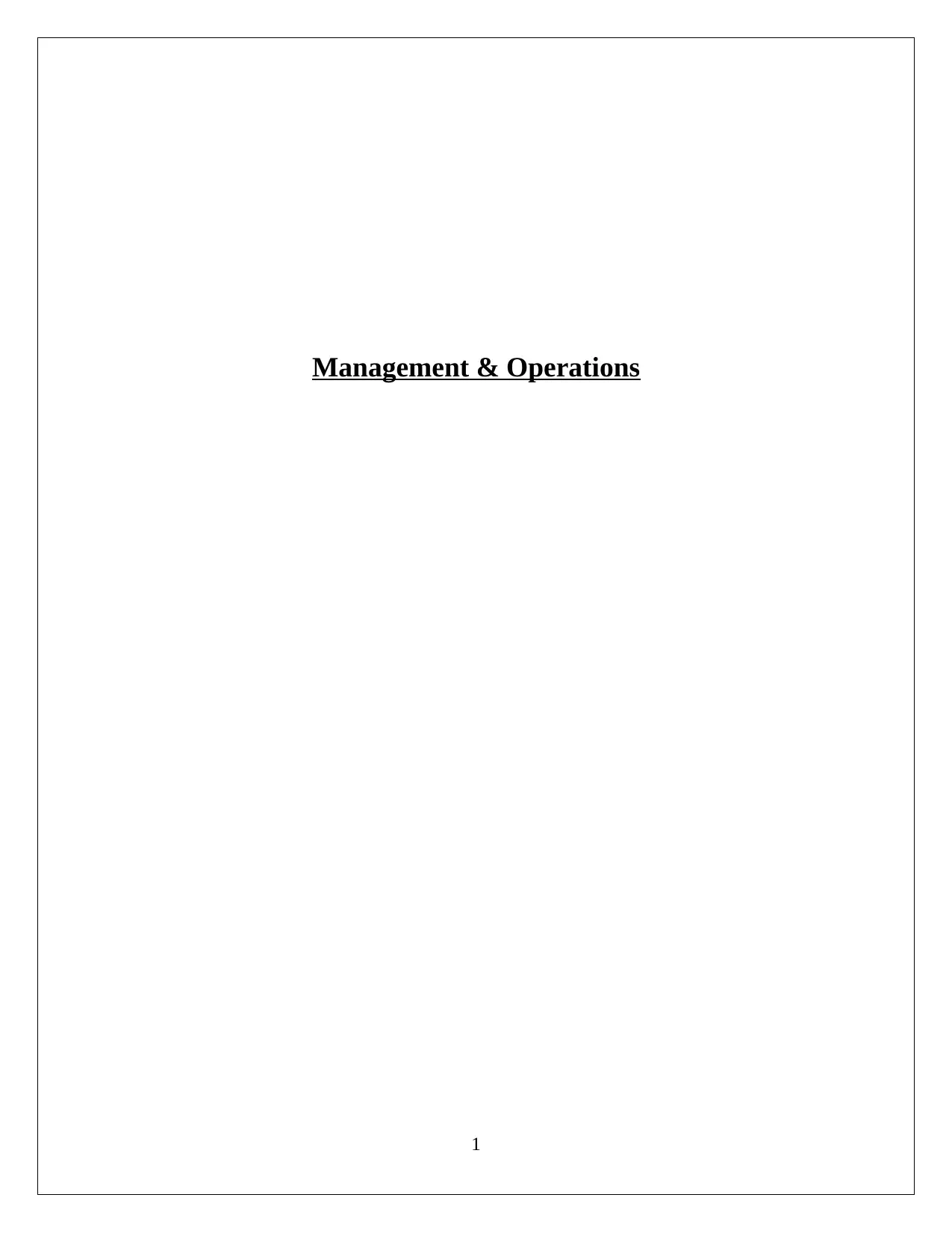
Management & Operations
1
1
Paraphrase This Document
Need a fresh take? Get an instant paraphrase of this document with our AI Paraphraser
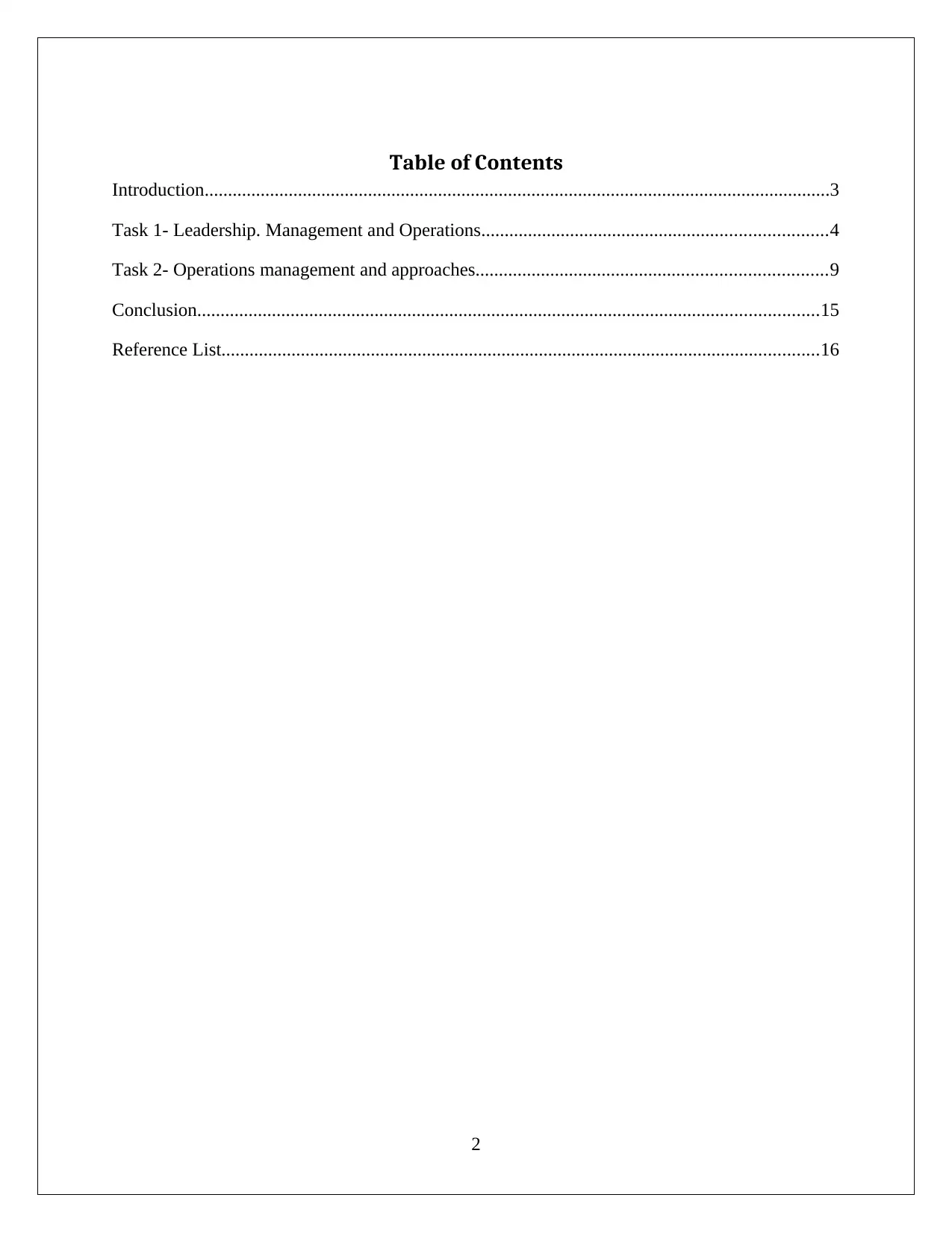
Table of Contents
Introduction......................................................................................................................................3
Task 1- Leadership. Management and Operations..........................................................................4
Task 2- Operations management and approaches...........................................................................9
Conclusion.....................................................................................................................................15
Reference List................................................................................................................................16
2
Introduction......................................................................................................................................3
Task 1- Leadership. Management and Operations..........................................................................4
Task 2- Operations management and approaches...........................................................................9
Conclusion.....................................................................................................................................15
Reference List................................................................................................................................16
2
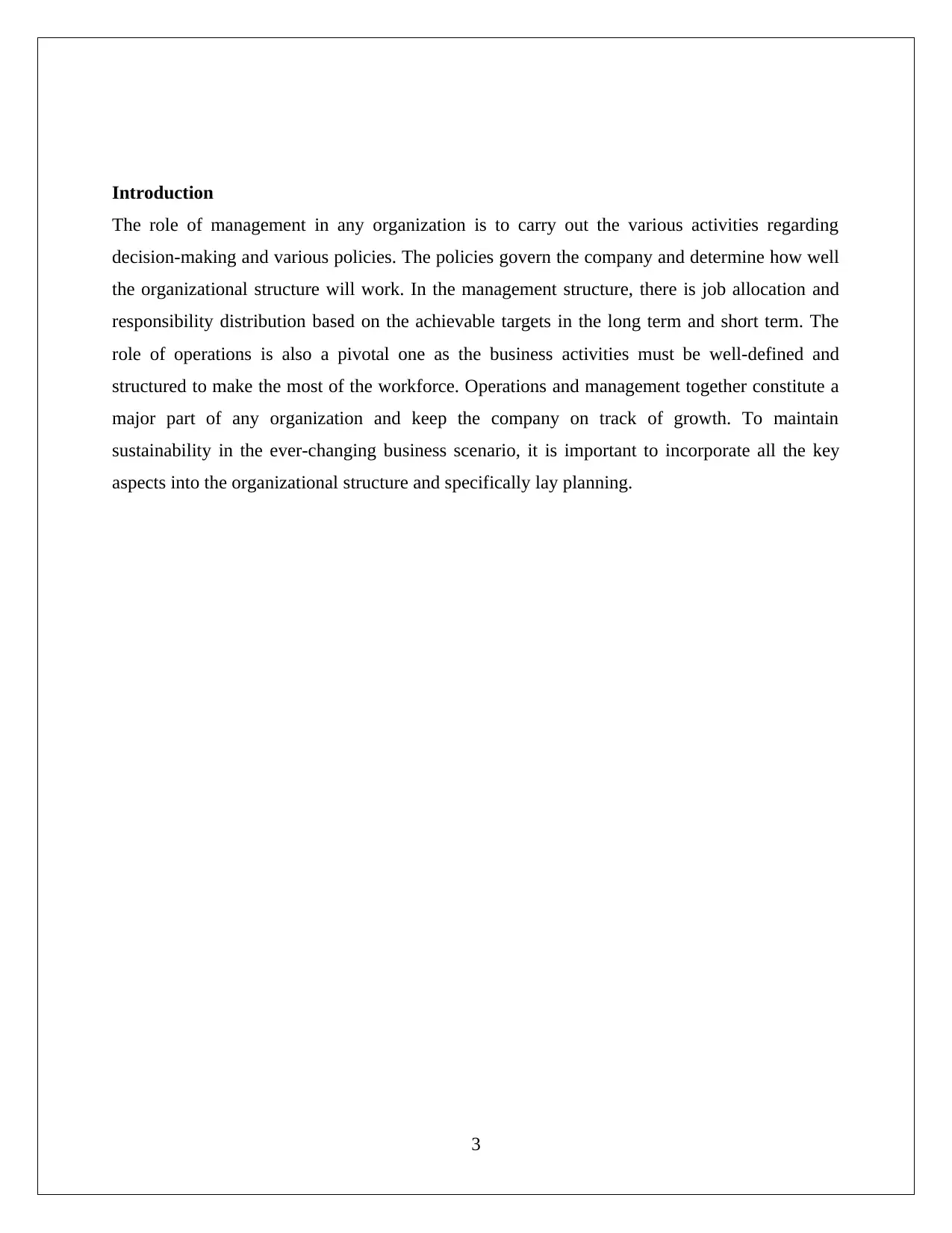
Introduction
The role of management in any organization is to carry out the various activities regarding
decision-making and various policies. The policies govern the company and determine how well
the organizational structure will work. In the management structure, there is job allocation and
responsibility distribution based on the achievable targets in the long term and short term. The
role of operations is also a pivotal one as the business activities must be well-defined and
structured to make the most of the workforce. Operations and management together constitute a
major part of any organization and keep the company on track of growth. To maintain
sustainability in the ever-changing business scenario, it is important to incorporate all the key
aspects into the organizational structure and specifically lay planning.
3
The role of management in any organization is to carry out the various activities regarding
decision-making and various policies. The policies govern the company and determine how well
the organizational structure will work. In the management structure, there is job allocation and
responsibility distribution based on the achievable targets in the long term and short term. The
role of operations is also a pivotal one as the business activities must be well-defined and
structured to make the most of the workforce. Operations and management together constitute a
major part of any organization and keep the company on track of growth. To maintain
sustainability in the ever-changing business scenario, it is important to incorporate all the key
aspects into the organizational structure and specifically lay planning.
3
⊘ This is a preview!⊘
Do you want full access?
Subscribe today to unlock all pages.

Trusted by 1+ million students worldwide
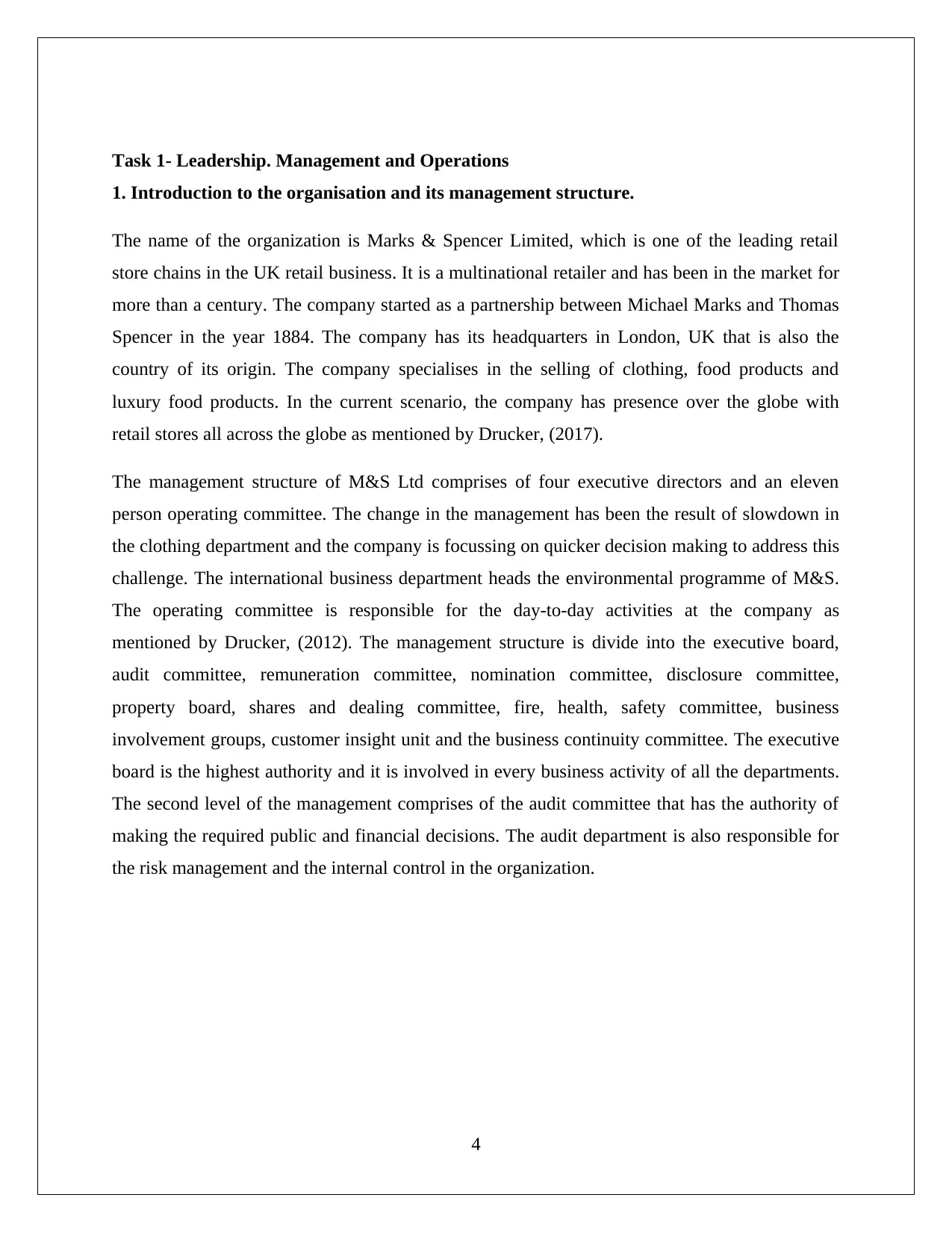
Task 1- Leadership. Management and Operations
1. Introduction to the organisation and its management structure.
The name of the organization is Marks & Spencer Limited, which is one of the leading retail
store chains in the UK retail business. It is a multinational retailer and has been in the market for
more than a century. The company started as a partnership between Michael Marks and Thomas
Spencer in the year 1884. The company has its headquarters in London, UK that is also the
country of its origin. The company specialises in the selling of clothing, food products and
luxury food products. In the current scenario, the company has presence over the globe with
retail stores all across the globe as mentioned by Drucker, (2017).
The management structure of M&S Ltd comprises of four executive directors and an eleven
person operating committee. The change in the management has been the result of slowdown in
the clothing department and the company is focussing on quicker decision making to address this
challenge. The international business department heads the environmental programme of M&S.
The operating committee is responsible for the day-to-day activities at the company as
mentioned by Drucker, (2012). The management structure is divide into the executive board,
audit committee, remuneration committee, nomination committee, disclosure committee,
property board, shares and dealing committee, fire, health, safety committee, business
involvement groups, customer insight unit and the business continuity committee. The executive
board is the highest authority and it is involved in every business activity of all the departments.
The second level of the management comprises of the audit committee that has the authority of
making the required public and financial decisions. The audit department is also responsible for
the risk management and the internal control in the organization.
4
1. Introduction to the organisation and its management structure.
The name of the organization is Marks & Spencer Limited, which is one of the leading retail
store chains in the UK retail business. It is a multinational retailer and has been in the market for
more than a century. The company started as a partnership between Michael Marks and Thomas
Spencer in the year 1884. The company has its headquarters in London, UK that is also the
country of its origin. The company specialises in the selling of clothing, food products and
luxury food products. In the current scenario, the company has presence over the globe with
retail stores all across the globe as mentioned by Drucker, (2017).
The management structure of M&S Ltd comprises of four executive directors and an eleven
person operating committee. The change in the management has been the result of slowdown in
the clothing department and the company is focussing on quicker decision making to address this
challenge. The international business department heads the environmental programme of M&S.
The operating committee is responsible for the day-to-day activities at the company as
mentioned by Drucker, (2012). The management structure is divide into the executive board,
audit committee, remuneration committee, nomination committee, disclosure committee,
property board, shares and dealing committee, fire, health, safety committee, business
involvement groups, customer insight unit and the business continuity committee. The executive
board is the highest authority and it is involved in every business activity of all the departments.
The second level of the management comprises of the audit committee that has the authority of
making the required public and financial decisions. The audit department is also responsible for
the risk management and the internal control in the organization.
4
Paraphrase This Document
Need a fresh take? Get an instant paraphrase of this document with our AI Paraphraser
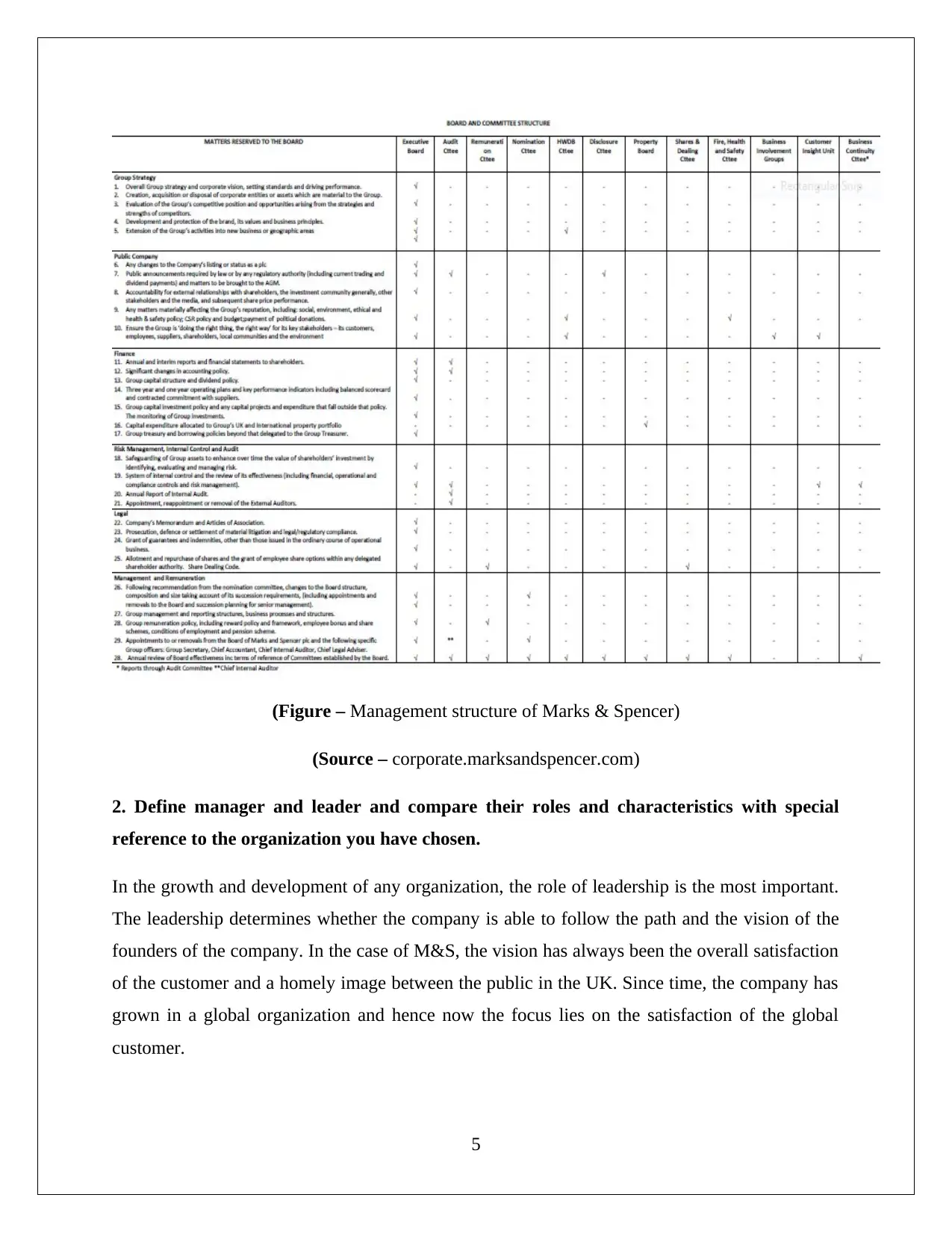
(Figure – Management structure of Marks & Spencer)
(Source – corporate.marksandspencer.com)
2. Define manager and leader and compare their roles and characteristics with special
reference to the organization you have chosen.
In the growth and development of any organization, the role of leadership is the most important.
The leadership determines whether the company is able to follow the path and the vision of the
founders of the company. In the case of M&S, the vision has always been the overall satisfaction
of the customer and a homely image between the public in the UK. Since time, the company has
grown in a global organization and hence now the focus lies on the satisfaction of the global
customer.
5
(Source – corporate.marksandspencer.com)
2. Define manager and leader and compare their roles and characteristics with special
reference to the organization you have chosen.
In the growth and development of any organization, the role of leadership is the most important.
The leadership determines whether the company is able to follow the path and the vision of the
founders of the company. In the case of M&S, the vision has always been the overall satisfaction
of the customer and a homely image between the public in the UK. Since time, the company has
grown in a global organization and hence now the focus lies on the satisfaction of the global
customer.
5
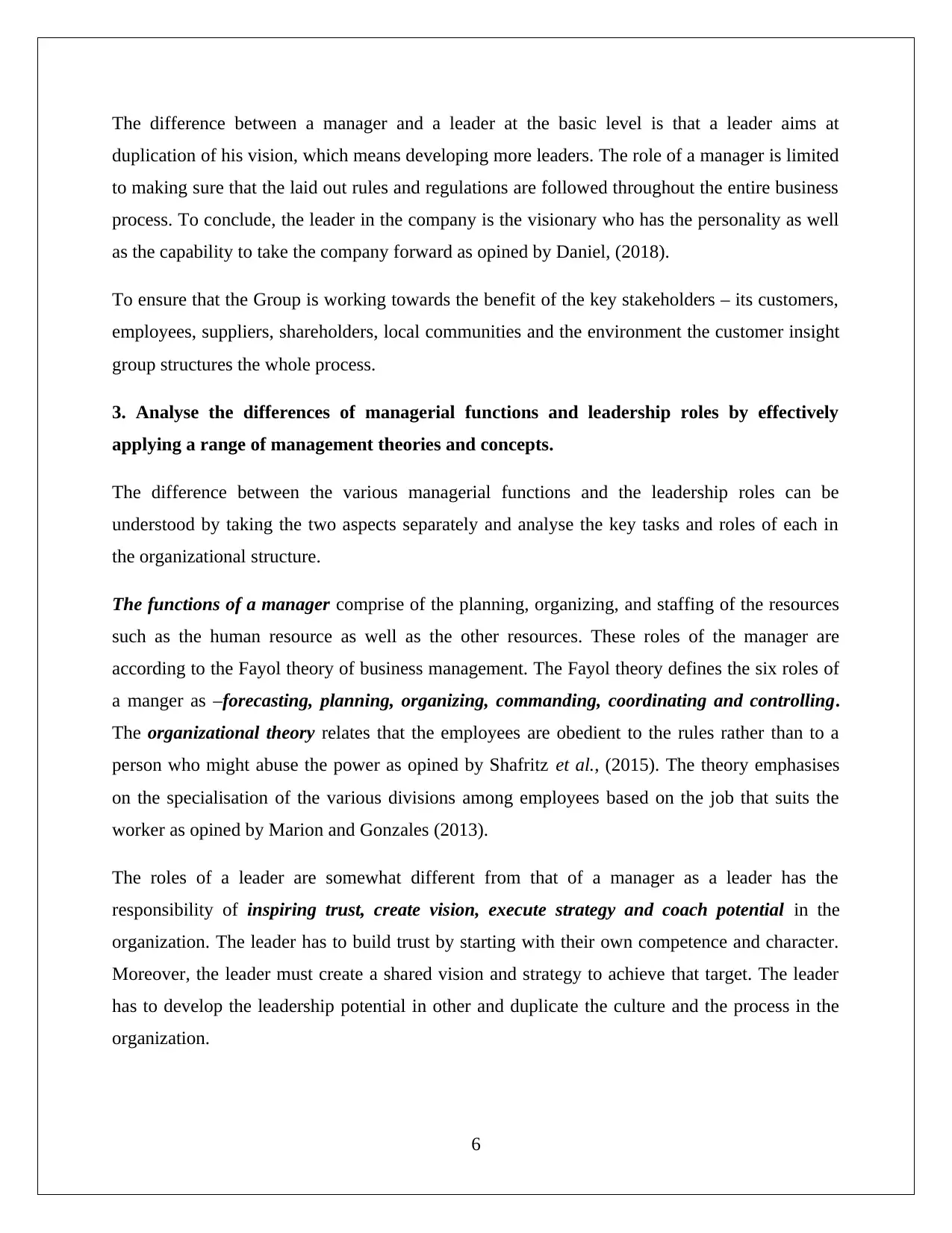
The difference between a manager and a leader at the basic level is that a leader aims at
duplication of his vision, which means developing more leaders. The role of a manager is limited
to making sure that the laid out rules and regulations are followed throughout the entire business
process. To conclude, the leader in the company is the visionary who has the personality as well
as the capability to take the company forward as opined by Daniel, (2018).
To ensure that the Group is working towards the benefit of the key stakeholders – its customers,
employees, suppliers, shareholders, local communities and the environment the customer insight
group structures the whole process.
3. Analyse the differences of managerial functions and leadership roles by effectively
applying a range of management theories and concepts.
The difference between the various managerial functions and the leadership roles can be
understood by taking the two aspects separately and analyse the key tasks and roles of each in
the organizational structure.
The functions of a manager comprise of the planning, organizing, and staffing of the resources
such as the human resource as well as the other resources. These roles of the manager are
according to the Fayol theory of business management. The Fayol theory defines the six roles of
a manger as –forecasting, planning, organizing, commanding, coordinating and controlling.
The organizational theory relates that the employees are obedient to the rules rather than to a
person who might abuse the power as opined by Shafritz et al., (2015). The theory emphasises
on the specialisation of the various divisions among employees based on the job that suits the
worker as opined by Marion and Gonzales (2013).
The roles of a leader are somewhat different from that of a manager as a leader has the
responsibility of inspiring trust, create vision, execute strategy and coach potential in the
organization. The leader has to build trust by starting with their own competence and character.
Moreover, the leader must create a shared vision and strategy to achieve that target. The leader
has to develop the leadership potential in other and duplicate the culture and the process in the
organization.
6
duplication of his vision, which means developing more leaders. The role of a manager is limited
to making sure that the laid out rules and regulations are followed throughout the entire business
process. To conclude, the leader in the company is the visionary who has the personality as well
as the capability to take the company forward as opined by Daniel, (2018).
To ensure that the Group is working towards the benefit of the key stakeholders – its customers,
employees, suppliers, shareholders, local communities and the environment the customer insight
group structures the whole process.
3. Analyse the differences of managerial functions and leadership roles by effectively
applying a range of management theories and concepts.
The difference between the various managerial functions and the leadership roles can be
understood by taking the two aspects separately and analyse the key tasks and roles of each in
the organizational structure.
The functions of a manager comprise of the planning, organizing, and staffing of the resources
such as the human resource as well as the other resources. These roles of the manager are
according to the Fayol theory of business management. The Fayol theory defines the six roles of
a manger as –forecasting, planning, organizing, commanding, coordinating and controlling.
The organizational theory relates that the employees are obedient to the rules rather than to a
person who might abuse the power as opined by Shafritz et al., (2015). The theory emphasises
on the specialisation of the various divisions among employees based on the job that suits the
worker as opined by Marion and Gonzales (2013).
The roles of a leader are somewhat different from that of a manager as a leader has the
responsibility of inspiring trust, create vision, execute strategy and coach potential in the
organization. The leader has to build trust by starting with their own competence and character.
Moreover, the leader must create a shared vision and strategy to achieve that target. The leader
has to develop the leadership potential in other and duplicate the culture and the process in the
organization.
6
⊘ This is a preview!⊘
Do you want full access?
Subscribe today to unlock all pages.

Trusted by 1+ million students worldwide
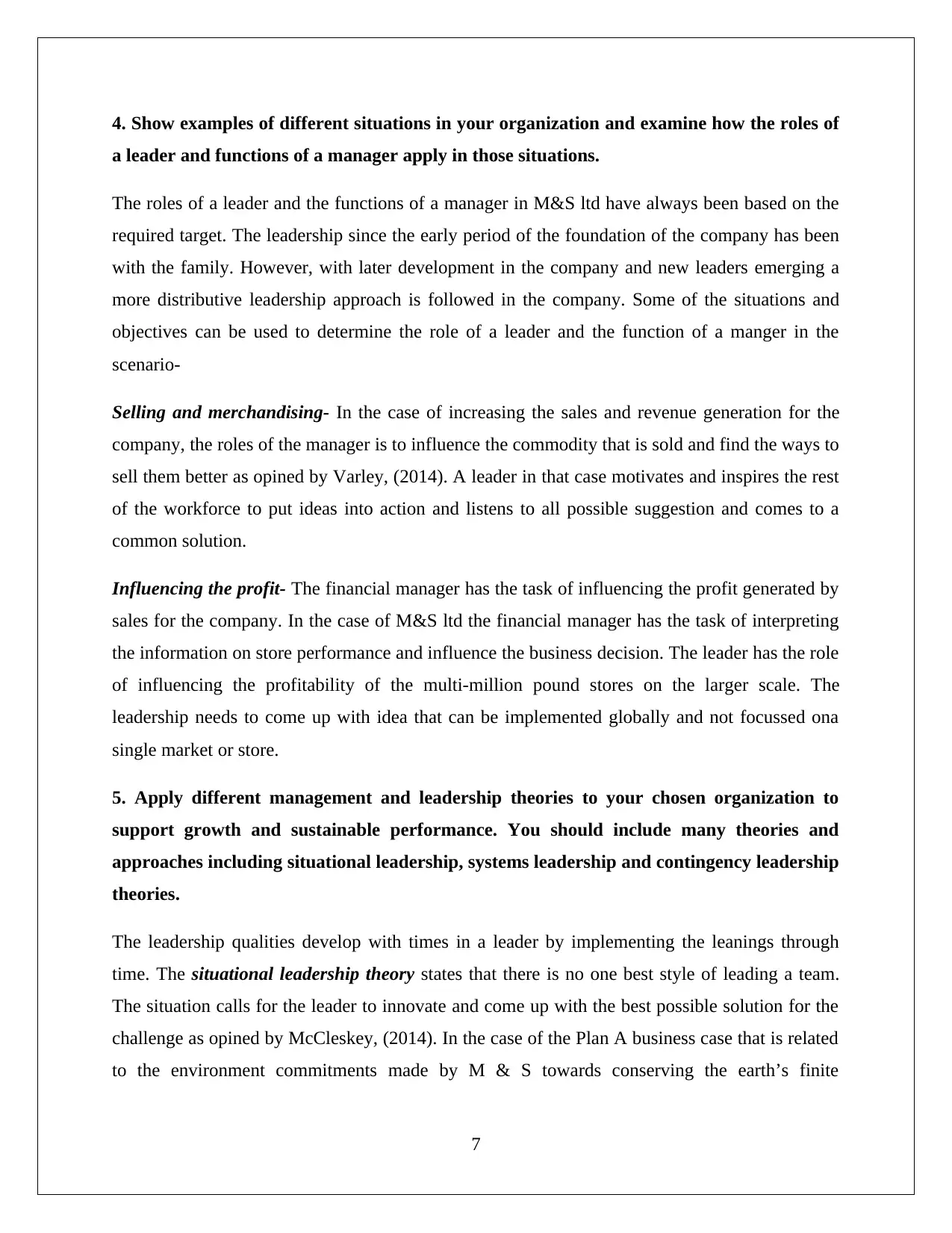
4. Show examples of different situations in your organization and examine how the roles of
a leader and functions of a manager apply in those situations.
The roles of a leader and the functions of a manager in M&S ltd have always been based on the
required target. The leadership since the early period of the foundation of the company has been
with the family. However, with later development in the company and new leaders emerging a
more distributive leadership approach is followed in the company. Some of the situations and
objectives can be used to determine the role of a leader and the function of a manger in the
scenario-
Selling and merchandising- In the case of increasing the sales and revenue generation for the
company, the roles of the manager is to influence the commodity that is sold and find the ways to
sell them better as opined by Varley, (2014). A leader in that case motivates and inspires the rest
of the workforce to put ideas into action and listens to all possible suggestion and comes to a
common solution.
Influencing the profit- The financial manager has the task of influencing the profit generated by
sales for the company. In the case of M&S ltd the financial manager has the task of interpreting
the information on store performance and influence the business decision. The leader has the role
of influencing the profitability of the multi-million pound stores on the larger scale. The
leadership needs to come up with idea that can be implemented globally and not focussed ona
single market or store.
5. Apply different management and leadership theories to your chosen organization to
support growth and sustainable performance. You should include many theories and
approaches including situational leadership, systems leadership and contingency leadership
theories.
The leadership qualities develop with times in a leader by implementing the leanings through
time. The situational leadership theory states that there is no one best style of leading a team.
The situation calls for the leader to innovate and come up with the best possible solution for the
challenge as opined by McCleskey, (2014). In the case of the Plan A business case that is related
to the environment commitments made by M & S towards conserving the earth’s finite
7
a leader and functions of a manager apply in those situations.
The roles of a leader and the functions of a manager in M&S ltd have always been based on the
required target. The leadership since the early period of the foundation of the company has been
with the family. However, with later development in the company and new leaders emerging a
more distributive leadership approach is followed in the company. Some of the situations and
objectives can be used to determine the role of a leader and the function of a manger in the
scenario-
Selling and merchandising- In the case of increasing the sales and revenue generation for the
company, the roles of the manager is to influence the commodity that is sold and find the ways to
sell them better as opined by Varley, (2014). A leader in that case motivates and inspires the rest
of the workforce to put ideas into action and listens to all possible suggestion and comes to a
common solution.
Influencing the profit- The financial manager has the task of influencing the profit generated by
sales for the company. In the case of M&S ltd the financial manager has the task of interpreting
the information on store performance and influence the business decision. The leader has the role
of influencing the profitability of the multi-million pound stores on the larger scale. The
leadership needs to come up with idea that can be implemented globally and not focussed ona
single market or store.
5. Apply different management and leadership theories to your chosen organization to
support growth and sustainable performance. You should include many theories and
approaches including situational leadership, systems leadership and contingency leadership
theories.
The leadership qualities develop with times in a leader by implementing the leanings through
time. The situational leadership theory states that there is no one best style of leading a team.
The situation calls for the leader to innovate and come up with the best possible solution for the
challenge as opined by McCleskey, (2014). In the case of the Plan A business case that is related
to the environment commitments made by M & S towards conserving the earth’s finite
7
Paraphrase This Document
Need a fresh take? Get an instant paraphrase of this document with our AI Paraphraser
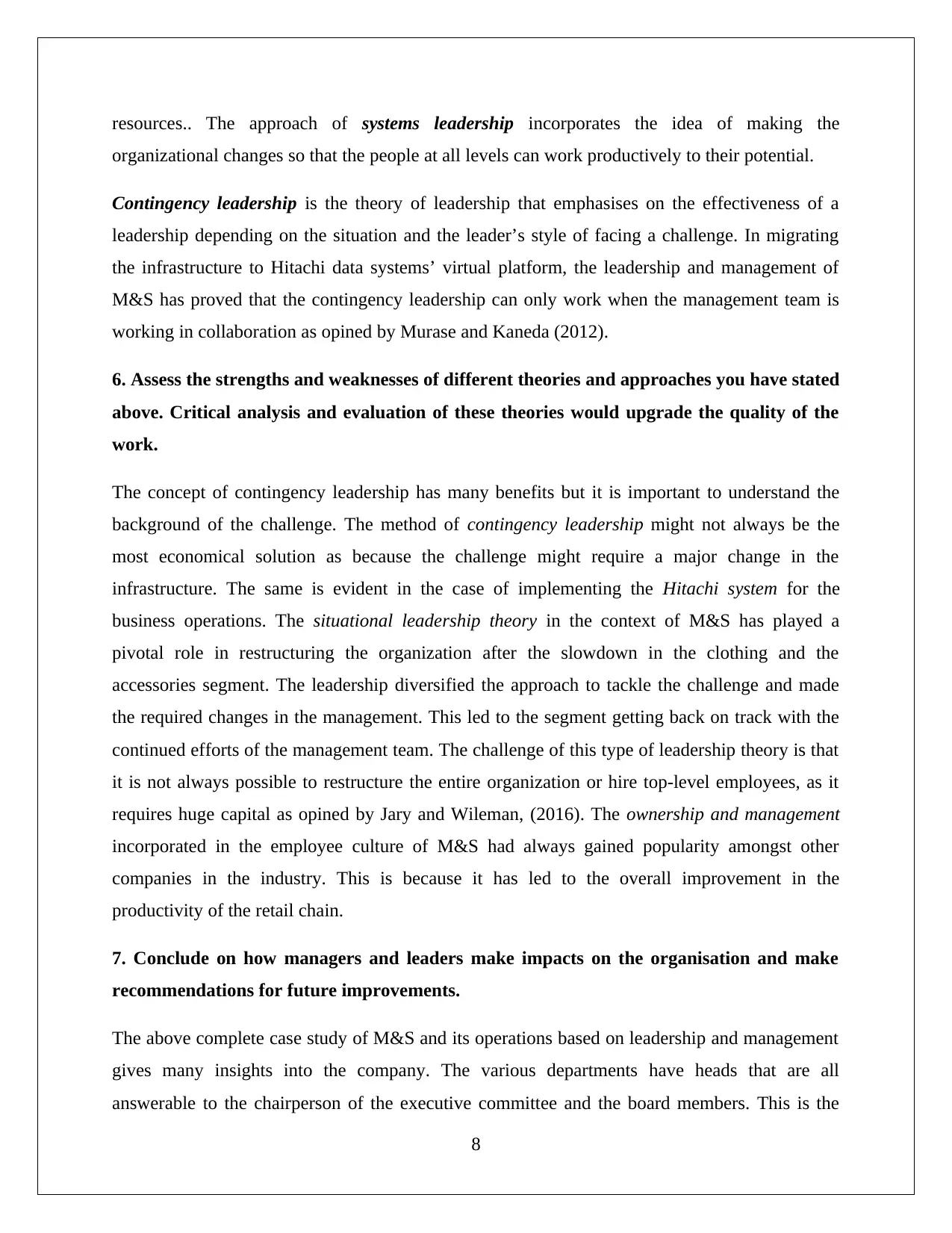
resources.. The approach of systems leadership incorporates the idea of making the
organizational changes so that the people at all levels can work productively to their potential.
Contingency leadership is the theory of leadership that emphasises on the effectiveness of a
leadership depending on the situation and the leader’s style of facing a challenge. In migrating
the infrastructure to Hitachi data systems’ virtual platform, the leadership and management of
M&S has proved that the contingency leadership can only work when the management team is
working in collaboration as opined by Murase and Kaneda (2012).
6. Assess the strengths and weaknesses of different theories and approaches you have stated
above. Critical analysis and evaluation of these theories would upgrade the quality of the
work.
The concept of contingency leadership has many benefits but it is important to understand the
background of the challenge. The method of contingency leadership might not always be the
most economical solution as because the challenge might require a major change in the
infrastructure. The same is evident in the case of implementing the Hitachi system for the
business operations. The situational leadership theory in the context of M&S has played a
pivotal role in restructuring the organization after the slowdown in the clothing and the
accessories segment. The leadership diversified the approach to tackle the challenge and made
the required changes in the management. This led to the segment getting back on track with the
continued efforts of the management team. The challenge of this type of leadership theory is that
it is not always possible to restructure the entire organization or hire top-level employees, as it
requires huge capital as opined by Jary and Wileman, (2016). The ownership and management
incorporated in the employee culture of M&S had always gained popularity amongst other
companies in the industry. This is because it has led to the overall improvement in the
productivity of the retail chain.
7. Conclude on how managers and leaders make impacts on the organisation and make
recommendations for future improvements.
The above complete case study of M&S and its operations based on leadership and management
gives many insights into the company. The various departments have heads that are all
answerable to the chairperson of the executive committee and the board members. This is the
8
organizational changes so that the people at all levels can work productively to their potential.
Contingency leadership is the theory of leadership that emphasises on the effectiveness of a
leadership depending on the situation and the leader’s style of facing a challenge. In migrating
the infrastructure to Hitachi data systems’ virtual platform, the leadership and management of
M&S has proved that the contingency leadership can only work when the management team is
working in collaboration as opined by Murase and Kaneda (2012).
6. Assess the strengths and weaknesses of different theories and approaches you have stated
above. Critical analysis and evaluation of these theories would upgrade the quality of the
work.
The concept of contingency leadership has many benefits but it is important to understand the
background of the challenge. The method of contingency leadership might not always be the
most economical solution as because the challenge might require a major change in the
infrastructure. The same is evident in the case of implementing the Hitachi system for the
business operations. The situational leadership theory in the context of M&S has played a
pivotal role in restructuring the organization after the slowdown in the clothing and the
accessories segment. The leadership diversified the approach to tackle the challenge and made
the required changes in the management. This led to the segment getting back on track with the
continued efforts of the management team. The challenge of this type of leadership theory is that
it is not always possible to restructure the entire organization or hire top-level employees, as it
requires huge capital as opined by Jary and Wileman, (2016). The ownership and management
incorporated in the employee culture of M&S had always gained popularity amongst other
companies in the industry. This is because it has led to the overall improvement in the
productivity of the retail chain.
7. Conclude on how managers and leaders make impacts on the organisation and make
recommendations for future improvements.
The above complete case study of M&S and its operations based on leadership and management
gives many insights into the company. The various departments have heads that are all
answerable to the chairperson of the executive committee and the board members. This is the
8
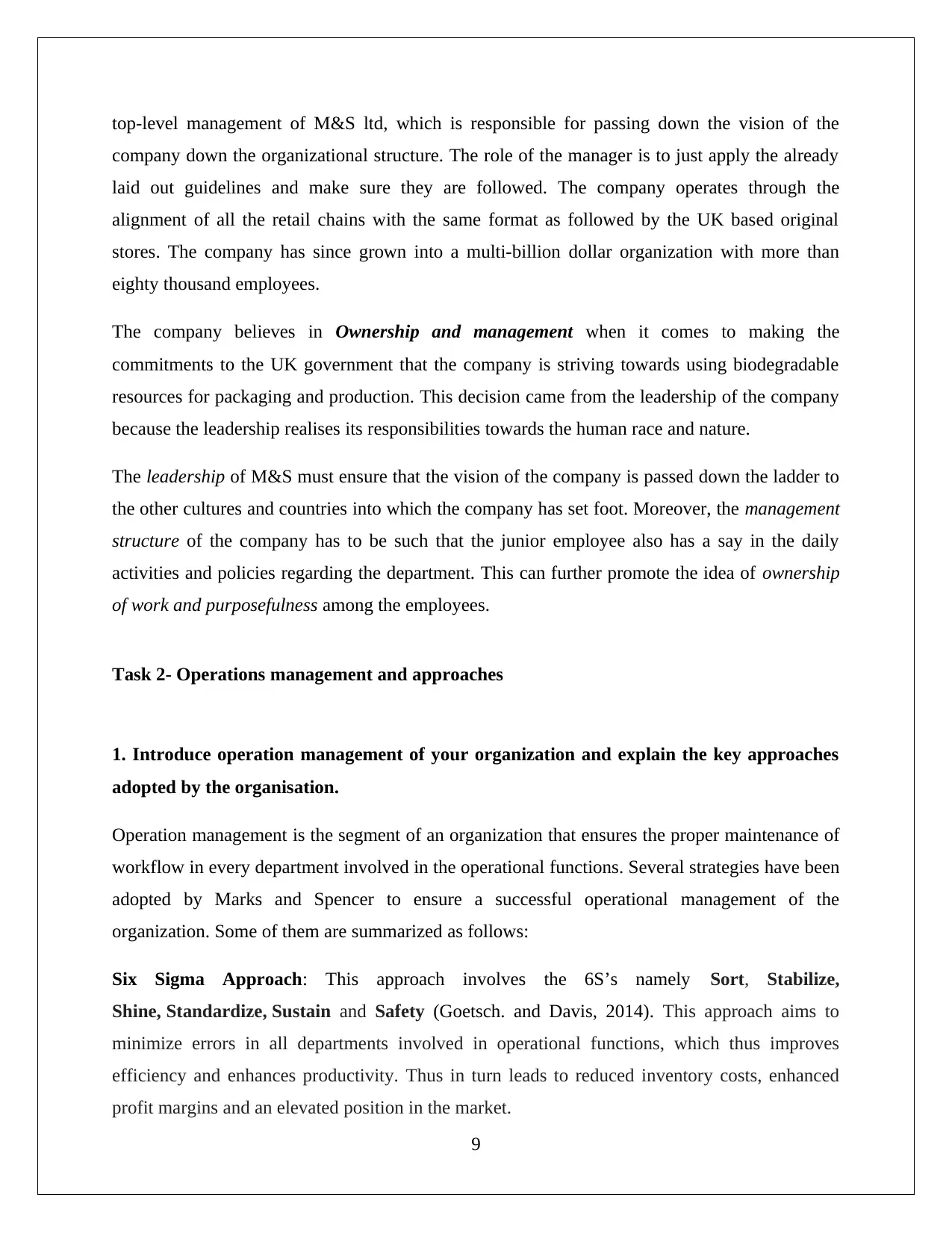
top-level management of M&S ltd, which is responsible for passing down the vision of the
company down the organizational structure. The role of the manager is to just apply the already
laid out guidelines and make sure they are followed. The company operates through the
alignment of all the retail chains with the same format as followed by the UK based original
stores. The company has since grown into a multi-billion dollar organization with more than
eighty thousand employees.
The company believes in Ownership and management when it comes to making the
commitments to the UK government that the company is striving towards using biodegradable
resources for packaging and production. This decision came from the leadership of the company
because the leadership realises its responsibilities towards the human race and nature.
The leadership of M&S must ensure that the vision of the company is passed down the ladder to
the other cultures and countries into which the company has set foot. Moreover, the management
structure of the company has to be such that the junior employee also has a say in the daily
activities and policies regarding the department. This can further promote the idea of ownership
of work and purposefulness among the employees.
Task 2- Operations management and approaches
1. Introduce operation management of your organization and explain the key approaches
adopted by the organisation.
Operation management is the segment of an organization that ensures the proper maintenance of
workflow in every department involved in the operational functions. Several strategies have been
adopted by Marks and Spencer to ensure a successful operational management of the
organization. Some of them are summarized as follows:
Six Sigma Approach: This approach involves the 6S’s namely Sort, Stabilize,
Shine, Standardize, Sustain and Safety (Goetsch. and Davis, 2014). This approach aims to
minimize errors in all departments involved in operational functions, which thus improves
efficiency and enhances productivity. Thus in turn leads to reduced inventory costs, enhanced
profit margins and an elevated position in the market.
9
company down the organizational structure. The role of the manager is to just apply the already
laid out guidelines and make sure they are followed. The company operates through the
alignment of all the retail chains with the same format as followed by the UK based original
stores. The company has since grown into a multi-billion dollar organization with more than
eighty thousand employees.
The company believes in Ownership and management when it comes to making the
commitments to the UK government that the company is striving towards using biodegradable
resources for packaging and production. This decision came from the leadership of the company
because the leadership realises its responsibilities towards the human race and nature.
The leadership of M&S must ensure that the vision of the company is passed down the ladder to
the other cultures and countries into which the company has set foot. Moreover, the management
structure of the company has to be such that the junior employee also has a say in the daily
activities and policies regarding the department. This can further promote the idea of ownership
of work and purposefulness among the employees.
Task 2- Operations management and approaches
1. Introduce operation management of your organization and explain the key approaches
adopted by the organisation.
Operation management is the segment of an organization that ensures the proper maintenance of
workflow in every department involved in the operational functions. Several strategies have been
adopted by Marks and Spencer to ensure a successful operational management of the
organization. Some of them are summarized as follows:
Six Sigma Approach: This approach involves the 6S’s namely Sort, Stabilize,
Shine, Standardize, Sustain and Safety (Goetsch. and Davis, 2014). This approach aims to
minimize errors in all departments involved in operational functions, which thus improves
efficiency and enhances productivity. Thus in turn leads to reduced inventory costs, enhanced
profit margins and an elevated position in the market.
9
⊘ This is a preview!⊘
Do you want full access?
Subscribe today to unlock all pages.

Trusted by 1+ million students worldwide
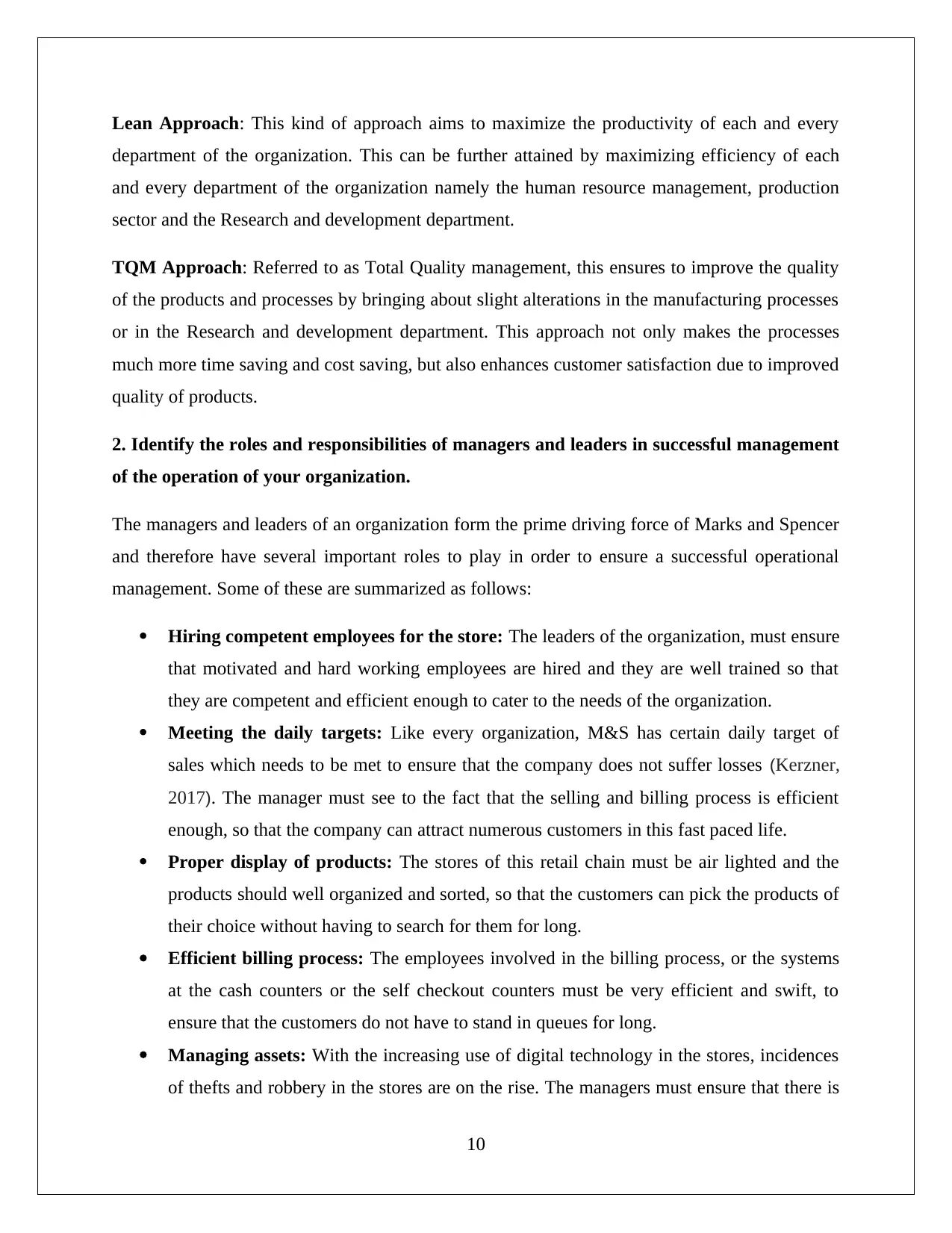
Lean Approach: This kind of approach aims to maximize the productivity of each and every
department of the organization. This can be further attained by maximizing efficiency of each
and every department of the organization namely the human resource management, production
sector and the Research and development department.
TQM Approach: Referred to as Total Quality management, this ensures to improve the quality
of the products and processes by bringing about slight alterations in the manufacturing processes
or in the Research and development department. This approach not only makes the processes
much more time saving and cost saving, but also enhances customer satisfaction due to improved
quality of products.
2. Identify the roles and responsibilities of managers and leaders in successful management
of the operation of your organization.
The managers and leaders of an organization form the prime driving force of Marks and Spencer
and therefore have several important roles to play in order to ensure a successful operational
management. Some of these are summarized as follows:
Hiring competent employees for the store: The leaders of the organization, must ensure
that motivated and hard working employees are hired and they are well trained so that
they are competent and efficient enough to cater to the needs of the organization.
Meeting the daily targets: Like every organization, M&S has certain daily target of
sales which needs to be met to ensure that the company does not suffer losses (Kerzner,
2017). The manager must see to the fact that the selling and billing process is efficient
enough, so that the company can attract numerous customers in this fast paced life.
Proper display of products: The stores of this retail chain must be air lighted and the
products should well organized and sorted, so that the customers can pick the products of
their choice without having to search for them for long.
Efficient billing process: The employees involved in the billing process, or the systems
at the cash counters or the self checkout counters must be very efficient and swift, to
ensure that the customers do not have to stand in queues for long.
Managing assets: With the increasing use of digital technology in the stores, incidences
of thefts and robbery in the stores are on the rise. The managers must ensure that there is
10
department of the organization. This can be further attained by maximizing efficiency of each
and every department of the organization namely the human resource management, production
sector and the Research and development department.
TQM Approach: Referred to as Total Quality management, this ensures to improve the quality
of the products and processes by bringing about slight alterations in the manufacturing processes
or in the Research and development department. This approach not only makes the processes
much more time saving and cost saving, but also enhances customer satisfaction due to improved
quality of products.
2. Identify the roles and responsibilities of managers and leaders in successful management
of the operation of your organization.
The managers and leaders of an organization form the prime driving force of Marks and Spencer
and therefore have several important roles to play in order to ensure a successful operational
management. Some of these are summarized as follows:
Hiring competent employees for the store: The leaders of the organization, must ensure
that motivated and hard working employees are hired and they are well trained so that
they are competent and efficient enough to cater to the needs of the organization.
Meeting the daily targets: Like every organization, M&S has certain daily target of
sales which needs to be met to ensure that the company does not suffer losses (Kerzner,
2017). The manager must see to the fact that the selling and billing process is efficient
enough, so that the company can attract numerous customers in this fast paced life.
Proper display of products: The stores of this retail chain must be air lighted and the
products should well organized and sorted, so that the customers can pick the products of
their choice without having to search for them for long.
Efficient billing process: The employees involved in the billing process, or the systems
at the cash counters or the self checkout counters must be very efficient and swift, to
ensure that the customers do not have to stand in queues for long.
Managing assets: With the increasing use of digital technology in the stores, incidences
of thefts and robbery in the stores are on the rise. The managers must ensure that there is
10
Paraphrase This Document
Need a fresh take? Get an instant paraphrase of this document with our AI Paraphraser
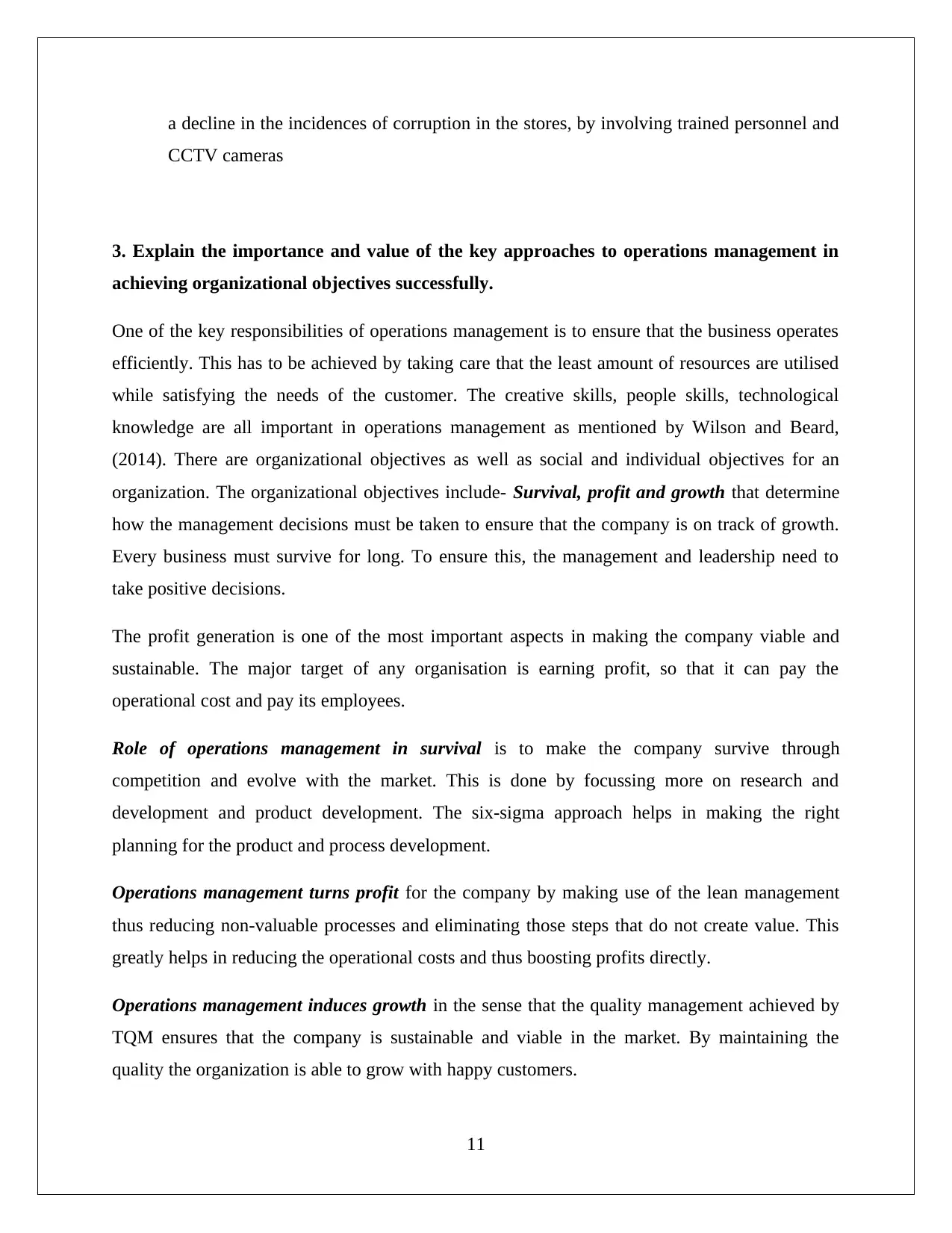
a decline in the incidences of corruption in the stores, by involving trained personnel and
CCTV cameras
3. Explain the importance and value of the key approaches to operations management in
achieving organizational objectives successfully.
One of the key responsibilities of operations management is to ensure that the business operates
efficiently. This has to be achieved by taking care that the least amount of resources are utilised
while satisfying the needs of the customer. The creative skills, people skills, technological
knowledge are all important in operations management as mentioned by Wilson and Beard,
(2014). There are organizational objectives as well as social and individual objectives for an
organization. The organizational objectives include- Survival, profit and growth that determine
how the management decisions must be taken to ensure that the company is on track of growth.
Every business must survive for long. To ensure this, the management and leadership need to
take positive decisions.
The profit generation is one of the most important aspects in making the company viable and
sustainable. The major target of any organisation is earning profit, so that it can pay the
operational cost and pay its employees.
Role of operations management in survival is to make the company survive through
competition and evolve with the market. This is done by focussing more on research and
development and product development. The six-sigma approach helps in making the right
planning for the product and process development.
Operations management turns profit for the company by making use of the lean management
thus reducing non-valuable processes and eliminating those steps that do not create value. This
greatly helps in reducing the operational costs and thus boosting profits directly.
Operations management induces growth in the sense that the quality management achieved by
TQM ensures that the company is sustainable and viable in the market. By maintaining the
quality the organization is able to grow with happy customers.
11
CCTV cameras
3. Explain the importance and value of the key approaches to operations management in
achieving organizational objectives successfully.
One of the key responsibilities of operations management is to ensure that the business operates
efficiently. This has to be achieved by taking care that the least amount of resources are utilised
while satisfying the needs of the customer. The creative skills, people skills, technological
knowledge are all important in operations management as mentioned by Wilson and Beard,
(2014). There are organizational objectives as well as social and individual objectives for an
organization. The organizational objectives include- Survival, profit and growth that determine
how the management decisions must be taken to ensure that the company is on track of growth.
Every business must survive for long. To ensure this, the management and leadership need to
take positive decisions.
The profit generation is one of the most important aspects in making the company viable and
sustainable. The major target of any organisation is earning profit, so that it can pay the
operational cost and pay its employees.
Role of operations management in survival is to make the company survive through
competition and evolve with the market. This is done by focussing more on research and
development and product development. The six-sigma approach helps in making the right
planning for the product and process development.
Operations management turns profit for the company by making use of the lean management
thus reducing non-valuable processes and eliminating those steps that do not create value. This
greatly helps in reducing the operational costs and thus boosting profits directly.
Operations management induces growth in the sense that the quality management achieved by
TQM ensures that the company is sustainable and viable in the market. By maintaining the
quality the organization is able to grow with happy customers.
11
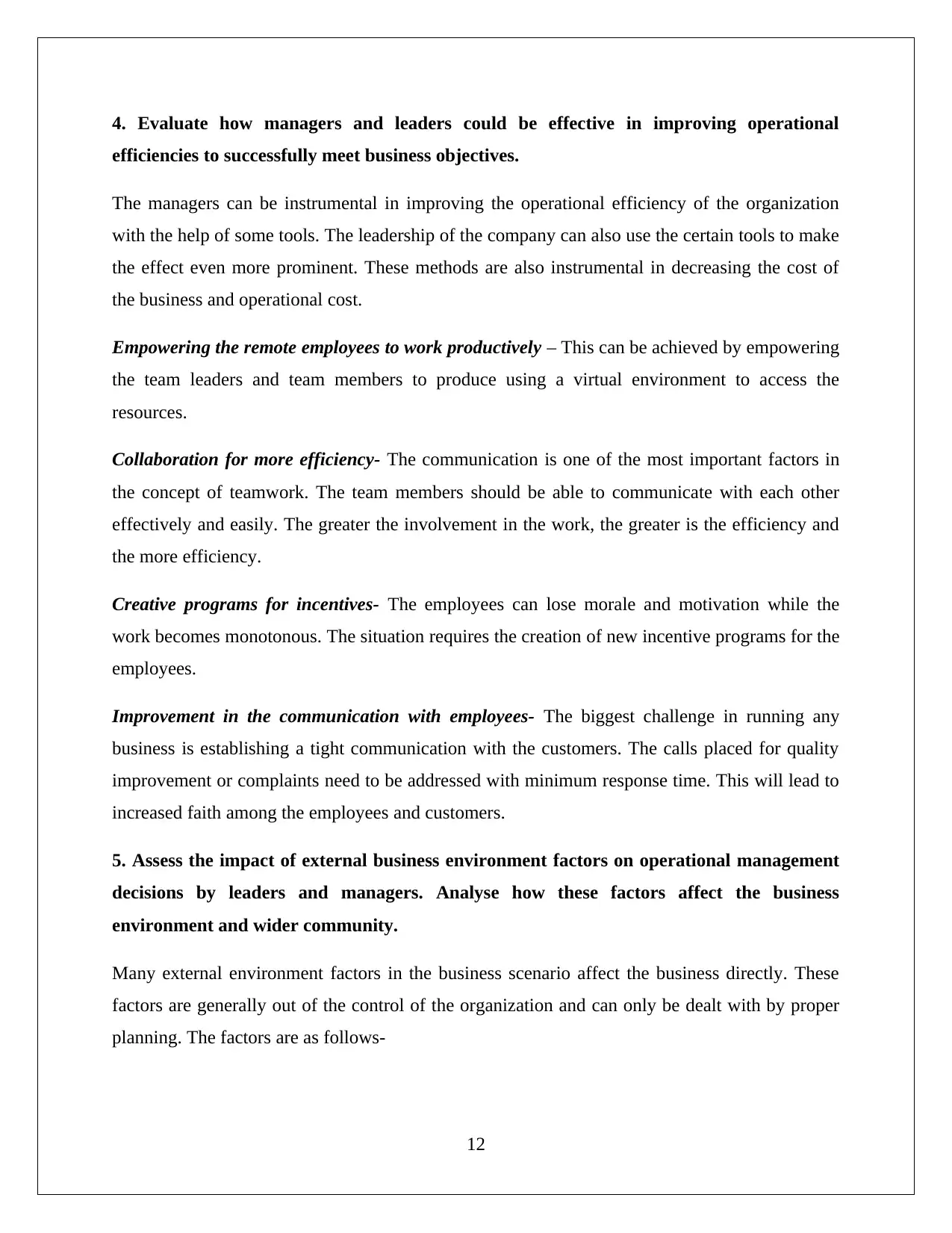
4. Evaluate how managers and leaders could be effective in improving operational
efficiencies to successfully meet business objectives.
The managers can be instrumental in improving the operational efficiency of the organization
with the help of some tools. The leadership of the company can also use the certain tools to make
the effect even more prominent. These methods are also instrumental in decreasing the cost of
the business and operational cost.
Empowering the remote employees to work productively – This can be achieved by empowering
the team leaders and team members to produce using a virtual environment to access the
resources.
Collaboration for more efficiency- The communication is one of the most important factors in
the concept of teamwork. The team members should be able to communicate with each other
effectively and easily. The greater the involvement in the work, the greater is the efficiency and
the more efficiency.
Creative programs for incentives- The employees can lose morale and motivation while the
work becomes monotonous. The situation requires the creation of new incentive programs for the
employees.
Improvement in the communication with employees- The biggest challenge in running any
business is establishing a tight communication with the customers. The calls placed for quality
improvement or complaints need to be addressed with minimum response time. This will lead to
increased faith among the employees and customers.
5. Assess the impact of external business environment factors on operational management
decisions by leaders and managers. Analyse how these factors affect the business
environment and wider community.
Many external environment factors in the business scenario affect the business directly. These
factors are generally out of the control of the organization and can only be dealt with by proper
planning. The factors are as follows-
12
efficiencies to successfully meet business objectives.
The managers can be instrumental in improving the operational efficiency of the organization
with the help of some tools. The leadership of the company can also use the certain tools to make
the effect even more prominent. These methods are also instrumental in decreasing the cost of
the business and operational cost.
Empowering the remote employees to work productively – This can be achieved by empowering
the team leaders and team members to produce using a virtual environment to access the
resources.
Collaboration for more efficiency- The communication is one of the most important factors in
the concept of teamwork. The team members should be able to communicate with each other
effectively and easily. The greater the involvement in the work, the greater is the efficiency and
the more efficiency.
Creative programs for incentives- The employees can lose morale and motivation while the
work becomes monotonous. The situation requires the creation of new incentive programs for the
employees.
Improvement in the communication with employees- The biggest challenge in running any
business is establishing a tight communication with the customers. The calls placed for quality
improvement or complaints need to be addressed with minimum response time. This will lead to
increased faith among the employees and customers.
5. Assess the impact of external business environment factors on operational management
decisions by leaders and managers. Analyse how these factors affect the business
environment and wider community.
Many external environment factors in the business scenario affect the business directly. These
factors are generally out of the control of the organization and can only be dealt with by proper
planning. The factors are as follows-
12
⊘ This is a preview!⊘
Do you want full access?
Subscribe today to unlock all pages.

Trusted by 1+ million students worldwide
1 out of 17
Related Documents
Your All-in-One AI-Powered Toolkit for Academic Success.
+13062052269
info@desklib.com
Available 24*7 on WhatsApp / Email
![[object Object]](/_next/static/media/star-bottom.7253800d.svg)
Unlock your academic potential
Copyright © 2020–2025 A2Z Services. All Rights Reserved. Developed and managed by ZUCOL.





